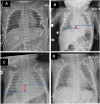Outcome analysis of a conservative approach to diaphragmatic paralysis following congenital cardiac surgery in neonates and infants: a bicentric retrospective study
- PMID: 34000037
- PMCID: PMC8691682
- DOI: 10.1093/icvts/ivab123
Outcome analysis of a conservative approach to diaphragmatic paralysis following congenital cardiac surgery in neonates and infants: a bicentric retrospective study
Abstract
Objectives: Diaphragmatic paralysis following congenital cardiac surgery is associated with significant morbidity and mortality. Spontaneous recovery of diaphragmatic function has been described, contrasting with centres providing early diaphragmatic plication. We aimed to describe the outcomes of a conservative approach, as well as to identify factors associated with a failure of the strategy.
Methods: This is a retrospective study of patients admitted after cardiac surgery and suffering unilateral diaphragmatic paralysis within 2 French Paediatric Cardiac Surgery Centers. The conservative approach, defined by the prolonged use of ventilation until successful weaning from respiratory support, was the primary strategy adopted in both centres. In case of unsuccessful evolution, a diaphragmatic plication was scheduled. Total ventilation time included invasive and non-invasive ventilation. Diaphragm asymmetry was defined by the number of posterior rib segments counted between the 2 hemi-diaphragms on the chest X-ray after cardiac surgery.
Results: Fifty-one neonates and infants were included in the analysis. Patients' median age was 12.0 days at cardiac surgery (5.0-82.0), and median weight was 3.5 kg (2.8-4.9). The conservative approach was successful for 32/51 patients (63%), whereas 19/51 patients (37%) needed diaphragm plication. There was no difference in patients' characteristics between groups. Respiratory support prolonged for 21 days or more and diaphragm asymmetry more than 2 rib segments were independently associated with the failure of the conservative strategy [odds ratio (OR) 6.9 (1.29-37.3); P = 0.024 and OR 6.0 (1.4-24.7); P = 0.013, respectively].
Conclusions: The conservative approach was successful for 63% of the patients. We identified risk factors associated with the strategy's failure.
Keywords: Congenital heart surgery; Diaphragmatic plication; Paediatric intensive care; Phrenic nerve injury.
© The Author(s) 2021. Published by Oxford University Press on behalf of the European Association for Cardio-Thoracic Surgery. All rights reserved.
Figures




References
-
- Gerard-Castaing N, Perrin T, Ohlmann C, Mainguy C, Coutier L, Buchs C. et al. Diaphragmatic paralysis in young children: a literature review. Pediatr Pulmonol 2019;54:1367–73. - PubMed
-
- Joho-Arreola AL, Bauersfeld U, Stauffer UG, Baenziger O, Bernet V.. Incidence and treatment of diaphragmatic paralysis after cardiac surgery in children. Eur J Cardiothorac Surg 2005;27:53–7. - PubMed
-
- Akay TH, Ozkan S, Gultekin B, Uguz E, Varan B, Sezgin A. et al. Diaphragmatic paralysis after cardiac surgery in children: incidence, prognosis and surgical management. Pediatr Surg Int 2006;22:341–6. - PubMed
-
- de Leeuw M, Williams JM, Freedom RM, Williams WG, Shemie SD, McCrindle BW.. Impact of diaphragmatic paralysis after cardiothoracic surgery in children. J Thorac Cardiovasc Surg 1999;118:510–17. - PubMed
-
- Floh AA, Zafurallah I, MacDonald C, Honjo O, Fan C-PS, Laussen PC.. The advantage of early plication in children diagnosed with diaphragm paresis. J Thorac Cardiovasc Surg 2017;154:1715–21.e4. - PubMed
MeSH terms
LinkOut - more resources
Full Text Sources
Other Literature Sources
Medical

